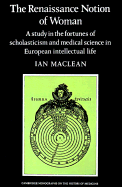 The Renaissance Notion of Woman
The Renaissance Notion of Woman 3 - Medicine, anatomy, physiology
Published online by Cambridge University Press: 01 June 2011
Summary
3.1.1 The subject of woman as seen by physiologists, anatomists and physicians is complex and multifaceted, because of its contiguity (and coincidence) with spermatology, hysterology, the science of the humours and theories of physical change. It is also very closely related to embryology, which exercises a deep influence on medical discussions about woman, and even determines to some degree the series of problems considered by medieval and Renaissance writers. In the excellent accounts of ancient embryology by Erna Lesky and H. B. Adelmann, this fact is pointed out, and the principal questions are listed: what is the origin of semen? do both sexes produce it? which part of the body develops first in the foetus? what determines sex and resemblance of children to parents? These questions give rise to a set of loci classici which are discussed by Renaissance doctors.
3.1.2 Renaissance medicine is distinct from the medieval discipline not only because of the work of humanists who produce the great editions, indices and commentaries of Aristotle, Hippocrates and Galen in the first half of the sixteenth century, but also because of the growth of experimental anatomy. The work of Andreas Vesalius, Gabriele Falloppio and Realdo Colombo is paralleled in the clinical sphere by the producers of consilia (case histories) and great writers on physiology, among them Jean Fernel. Although most doctors refer to ancient sects (the ‘practici’ who follow Averroes, the ‘peripatetici’, the ‘Galenici’, the ‘methodici’, the ‘empirici’), the vast majority of them are, according to Adelmann, ‘thoroughgoing Galenists at heart’, but influenced to different degrees by Aristotle, Avicenna and Hippocrates.
- Type
- Chapter
- Information
- The Renaissance Notion of WomanA Study in the Fortunes of Scholasticism and Medical Science in European Intellectual Life, pp. 28 - 46Publisher: Cambridge University PressPrint publication year: 1980
- 5
- Cited by


